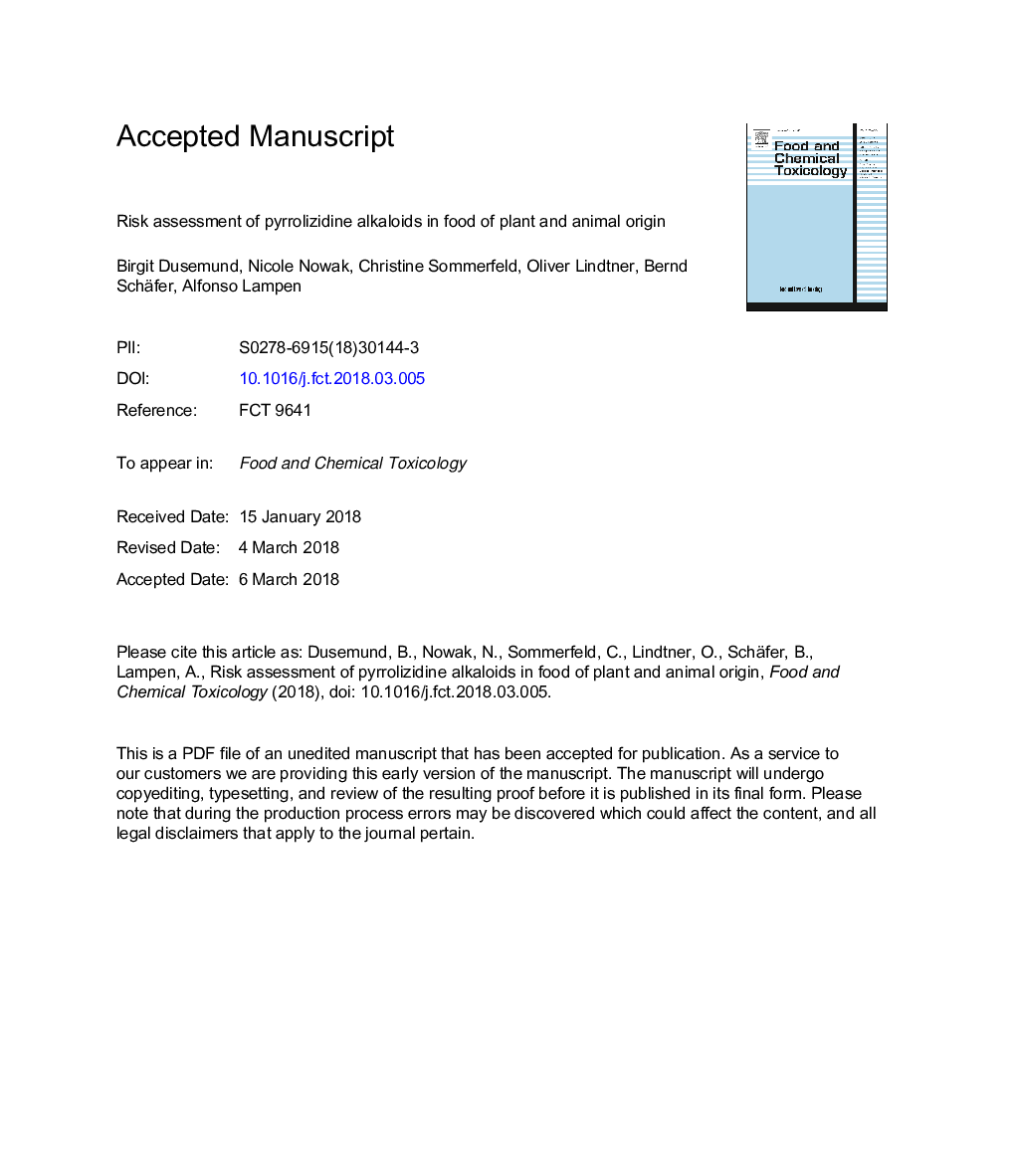| کد مقاله | کد نشریه | سال انتشار | مقاله انگلیسی | نسخه تمام متن |
|---|---|---|---|---|
| 8547540 | 1561731 | 2018 | 33 صفحه PDF | دانلود رایگان |
عنوان انگلیسی مقاله ISI
Risk assessment of pyrrolizidine alkaloids in food of plant and animal origin
ترجمه فارسی عنوان
ارزیابی ریسک آلکالوئیدهای پیررولیزیدین در مواد غذایی گیاهان و حیوانات
دانلود مقاله + سفارش ترجمه
دانلود مقاله ISI انگلیسی
رایگان برای ایرانیان
کلمات کلیدی
ARfDBFRHSOSNOAELHVODDHPEFSAJECFABMDGITCOTNTPNOELPTDILOQBMDL10pyrrolizidine alkaloids - آلکالوئیدهای پیررولیزیدینIARC یا International Agency for Research on Cancer - آژانس بین المللی تحقیقات سرطانInternational Agency for Research on Cancer - آژانس بین المللی تحقیقات سرطانEuropean Food Safety Authority - اداره ایمنی اروپاNational Toxicology Program - برنامه سم شناسی ملیhepatic veno-occlusive disease - بیماری انسدادی ورید کبدیMargin of exposure - حاشیه قرار گرفتن در معرضLOD یا Limit of detection - حد تشخیصFood - خوراک یا غذاGastrointestinal tract - دستگاه گوارشAcute reference dose - دوز مرجع حادbenchmark dose - دوز معادلGenotoxic carcinogens - سرطان زاHepatic sinusoidal obstruction syndrome - سندرم انسداد سینوسی کبدیUncertainty factor - عدم قطعیتlimit of quantification - محدودیت اندازه گیریlimit of detection - محدودیت تشخیصnot specified - مشخص نشده استprovisional tolerable daily intake - مصرف روزانه قابل تحمل روزانهFood supplements - مکمل های غذاییPAS - نهNo observed effect level - هیچ سطح اثر مشاهده شدهNo observed adverse effect level - هیچ عوارض جانبی مشاهده نشدهMOE - وزارت صنایع
موضوعات مرتبط
علوم زیستی و بیوفناوری
علوم کشاورزی و بیولوژیک
دانش تغذیه
چکیده انگلیسی
Acute liver toxicity, specifically in the form of hepatic veno-occlusive disease (HVOD), is known from reports on human poisonings following ingestions of 1,2-unsaturated pyrrolizidine alkaloids (PAs) containing herbs. Recently PA exposure via common foods contaminated via PA-producing plants raised concern, especially regarding the potential of genotoxicity and carcinogenicity. The health risks related to the estimated exposures to PAs from food were assessed. With respect to common foods, herbal teas and teas are the main sources through which consumers can be exposed to PAs. For high long-term consumption of these foods a possible health concern has been revealed in the assessment of chronic risks referring to a BMDL10 of 237â¯Î¼g/kg bw per day recently established by EFSA based on model averaging for data on riddelliine. However, acute health damage from acute or short-term intake of PAs via common food is considered to be unlikely. Food supplements on the basis of PA-producing plants may significantly contribute to PA exposures and their intake is associated with risks of acute and chronic toxicity. However, no health risks have to be expected from the consumption of food supplements based on oil-based preparations of PA-producing plants, which were described to be free of PAs.
ناشر
Database: Elsevier - ScienceDirect (ساینس دایرکت)
Journal: Food and Chemical Toxicology - Volume 115, May 2018, Pages 63-72
Journal: Food and Chemical Toxicology - Volume 115, May 2018, Pages 63-72
نویسندگان
Birgit Dusemund, Nicole Nowak, Christine Sommerfeld, Oliver Lindtner, Bernd Schäfer, Alfonso Lampen,
